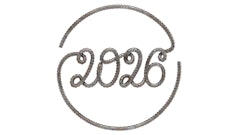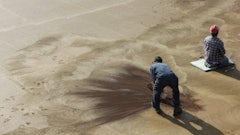
This article has been updated at ForConstructionPros.com/21202109.
A few years ago GFRC became a buzzword for decorative fabricators. I will give a short history of the origins of GFRC and explain the products I use and how I incorporate the GFRC methods in my projects.
Glass fiber reinforced concrete (GFRC) has been around for decades but only recently has it made its way into the world of decorative concrete. The GFRC techniques were originally developed by Russia in the 1940s, but the glass fiber used then lost strength over time because the glass would break down in the alkaline environment of concrete. In the 1970s, Owens Corning developed an alkali-resistant glass fiber which resulted in the rapid spread of GFRC technology. In simple terms, the GFRC product has synergistic properties that allow for the creation of thinner, stronger and more crack-resistant concrete.
Decorative concrete fabricators began adopting the GFRC technology when they realized they could achieve the same benefits as the guys making panels for cladding the exteriors of buildings. The ability to create thinner, lighter, more durable pieces is also a huge benefit when fabricating countertops, fireplace surrounds, outdoor furniture, etc. The incorporation of GFRC products has resulted in the use of new techniques and finishes, specifically the use of a spray technique for creating a thin face coat that is backed up by a fiber-fortified mix.
Products
Here are the GFRC products I use today in most of my projects:
- Concentrated Curing Polymer that works as a curing agent for cement and adds polymer strength to the final concrete matrix.
- AR Glass Fibers become integral with the concrete and add flexural and tensile strength
- AR Glass Fiber Scrim is a flat woven mat for additional glass fiber reinforcement
- Super Plasticizer/Water Reducer acts as a wetting agent to reduce water requirements and improve final strength
Spraying the face coat
When using GFRC spray technique the first step is to spray in the face coat. This face coat mix has to be very liquid in order to be sprayed into a mold. I have developed my own bagged face coat mix that provides some additional stickiness but you can also find basic sand and cement designs online that will work well. My face coat mix consists of 25 pounds of mix, 1.5 quarts of water, 1 quart of curing polymer, 1 ounce of water reducer and desired pigment. You’ll notice there are no fibers used in the face coat mix — you don’t want the finished piece to show fibers.
First I mix the water, curing polymer, pigment and water reducer in a 5-gallon bucket. Next I add the face coat mix — if the mixture is too dry add 0.5 ounces of water reducer and remix. Allow the mix to flash set for about 5 minutes then remix before spraying. You should be able to easily pour the mix into your hopper.
I use an inexpensive drywall hopper gun for spraying. If the mix won’t flow from your hopper, it is too thick. Your spray should come out of the gun like a wet splatter.
Spray the face coat to 18-inch thickness. With a bristle brush, brush the face coat in the mold to push out any air pockets, particularly in the corners and edges of the form to consolidate the mix.
The backup mix
Once my face coat is sprayed I begin mixing the backup coat. Timing is important — you do not want the face coat completely dry or the backup coat will not bond properly. Ideally you want the face coat mix to begin to stiffen so the backup coat does not push through while still getting a good bond between the face and backup coats.
I use two different flavors of backup mix, depending on the application. For flat surfaces I use a self-consolidating backup mix consisting of 70 pounds of my Countertop Mix, 1.5 quarts of curing polymer, 3 ounces of water reducer, 4 quarts of water, pigment and 1 pound of AR glass fiber. For a vertical surface I make a stiffer vertical mix that is the same as the self-consolidating mix formula without the water reducer.
For both mixes my first step is to combine all of the liquids in a 25-gallon bucket. I then add the 70-pound bag of Countertop Mix to the bucket and mix with a hand-held mortar mixer with a high-viscosity paddle. For the self-consolidating backup coat I mix to the consistency of a milkshake, while the vertical back-up mix should be mixed to the consistency of wet oatmeal. Next I slowly mix in the AR fibers while reducing the mixer rpm — mixing the fibers too vigorously will break down their structural integrity.
Once the backup coat is mixed it will be poured into the mold (self-consolidating) or applied by hand (vertical) behind my face coat mix. The final thickness of the piece is dependent on the overall size of the project. For a typical countertop or fireplace surround I generally shoot for a 1-inch thickness. For small pieces like tiles you can go as thin as 38-inch thick. I also recommend trowelling the back of the piece, particularly if it needs to rest or butt up against a flat surface. There’s no need for perfection on the back side of the piece since the back will not be seen, but it is important to have a flat, smooth surface for installation.
Final steps
Once the piece is demolded I will buff the piece, fill any bug holes with a matching color paste, lightly polish and seal prior to installation. Today I use the same GFRC reinforcement when doing more traditional finishes like polished, hard trowelled and my signature pressed finish.




















